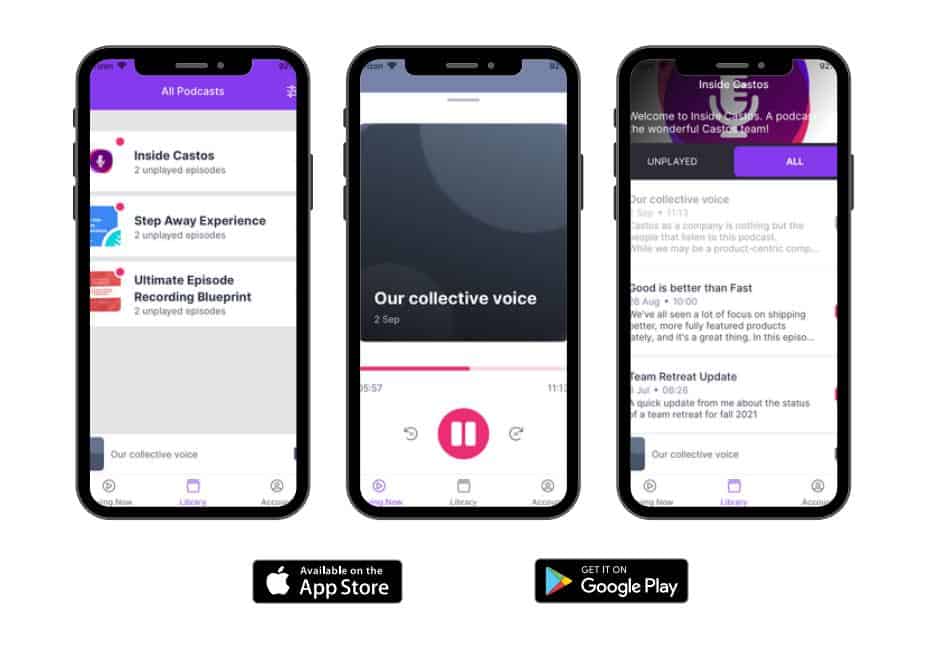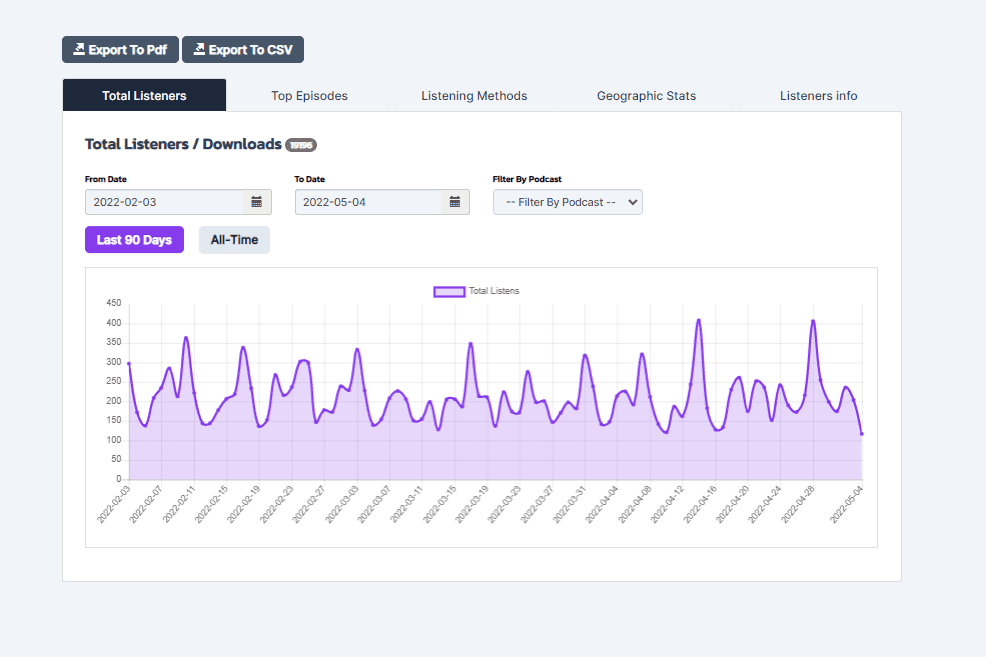You’ve created the first episode of your private company podcast (sometimes called a corporate podcast) and you’re happy with the result. Now you’re wondering how to share it; how to turn your coworkers into listeners. If you want your internal company podcast to be successful, you need a launch plan.
One of the major benefits of producing an internal company podcast is that your listenership is fixed. Whereas a public podcast could potentially gain millions of listeners, an internal company podcast (which is technically a private podcast) will only have an audience the size of the company. You know exactly who might listen to your show. You probably have all of their email addresses already.
This means that marketing an internal company podcast is different than marketing a traditional podcast. But it’s also a bit easier. However, you will need to take a different approach.
In this article, we lay out the important steps to distribute your company show. If you want to know how to launch an internal company podcast, you’re in the right place!
First, Choose a Quality Podcast Host
Before you do anything else, your first step is to choose a quality podcast host. This is an important service that will make your show available to your organization.
Your podcast host is a service that houses your show. You will upload episodes to the host who then makes those episodes available to your audience by way of an RSS feed. The feed can distribute episodes to your website or various podcast listening apps.
“Wait,” you might be thinking. “Can’t I just email the audio file to everyone at my company?”
That will work, but your engagement will suffer because people prefer to listen to podcasts through their favorite listing app (like Apple Podcasts, Google Podcasts, or Spotify). They want to listen to your show while they drive, exercise, or cook dinner, not at their work desk.
Furthermore, the RSS feed created by your host creates a library of content that can be enjoyed at any time. When new employees join your team, they’ll be able to catch up on old episodes. Your team will be able to look back at past episodes at any time, which is especially helpful if you intend to use your show to disseminate company information.
While there are plenty of options when it comes to podcast hosts, we strongly recommend using Castos (because that’s us!). Our platform is easy and offers powerful features to grow your audience and automate your workflow, especially if your company’s website uses WordPress.
Tip
Castos offers a 14-day trial, then plans start at $19 and come with unlimited storage, separate podcasts, and unlimited episodes. And all plans have generous download allowances. Start your free trial.
How to Launch an Internal Company Podcast in 10 Steps
Once you’re set up with a podcast host, you’re ready to launch your internal company podcast. Launching a podcast isn’t challenging, but it requires some work. Follow these steps to successfully launch your show.
Action
Haven’t started your show yet? We have a full guide to help you get started: How to Start a Podcast: Your 2021 Step-By-Step Guide
1. Identify your company’s announcement process
Your company may already have an internal communications process or workflow to notify everyone when new information is available. For instance, when policies change, someone probably sends an email, pushes a notification on an app, or distributes a paper memo.
If your company has a system like this, it could be all you need to launch an internal company podcast. All you have to do is find the manager of that system and ask how to get your podcast included.
For example, if your company has a monthly newsletter, that’s definitely somewhere you want your show to be mentioned. Find whoever puts the newsletter together and ask what they need from you to promote your show. You may have to supply copy, images, and links.
That said, do not rely on just a single outreach technique. Not everyone reads that newsletter, so you should also find other ways to reach people within the organization, such as the company Slack or Teams workspace or the company Twitter account.
2. Enlist the help of a distribution team
Depending on the nature of the company and your role, you may need the help of some team members in the organization to distribute your show. This is especially true in large organizations where a single person is unlikely to have access to everything.
For instance, if you don’t have access to everyone’s email address, you may need the assistance of HR to notify the company when a new episode is available. If you want to hang flyers around your company’s campus, you may need help from people who work in different buildings.
3. Establish an approval process
Depending on the makeup and hierarchy of your organization, you may need someone to approve each episode before you distribute it to your team. If your company is especially bureaucratic, you may need multiple people to sign off on it before you can publish.
In some organizations, the approval process varies based on the topic of each podcast episode. For instance, if an episode mentions a recent marketing campaign, the marketing team is required to approve it. If an episode mentions a change to the company’s benefits package, human resources is required to approve it.
If you haven’t already, now is a good time to establish that process so there aren’t any future delays. Ideally, you want the approval process to take less time than your publishing gap. If you publish every two weeks, the approval process should be no more than a week so you have time to make changes.
Of course, if you are in a leadership role and don’t require anyone’s approval, this step doesn’t apply to you. Although it’s a good idea to have someone listen to each episode before you publish just to catch any errors or mistakes.
4. Refine your recording process
Once the first episode of your internal podcast is ready to go, you will probably notice some issues with your audio. But don’t worry, this is expected. You won’t get your audio right for the first episode. In fact, it may take several episodes before you learn how to record clear and distraction free audio.
The best way to improve your audio is to improve your recording space. While it’s possible to clean up audio during the editing process, it’s easier for everyone if you record quality audio in the beginning. How do you get clean audio?
- Build a proper recording environment. You need a space with good audio acoustics that limits reverb as much as possible. Learn how to build a recording space in our full guide.
- Use proper mic techniques, such as maintaining the same distance from the mic and keeping your hands off the device. Learn more in our full guide on mic techniques.
- Create a repeatable recording workflow that you can work through quickly and outsource segments to other people on your team.
- Use professional podcast recording software (rather than the default recording app that came with your computer). Check out our recording software recommendations.
Action
Still not comfortable recording episodes? Lean more: How to Record a Podcast: A Super Simple Podcast Recording Workflow
5. Don’t be afraid to outsource
If you have some resources at your disposal, don’t be afraid to hire some outside help to elevate your podcast. There are lots of services, agencies, and freelancers who have podcast-specific experience. They can be brought in to handle little pieces of the process, manage the entire production, or anything in between.
This trip is especially helpful if the podcast isn’t the only thing on your plate. If you have other responsibilities within your organization, you may not have the necessary time to produce a quality show. In this case, it’s best to bring in someone who is suited to the job.
Many podcasters prefer to outsource the editing portion of their workflow. Editing requires technical knowledge and experience with editing software. It also requires patience because editing can be tedious.
But editing isn’t the only component of your show that you can outsource. you could hire a designer to create social media contents. You might hire a virtual assistant to publish episodes, write show notes, or transcribe your audio.
Note
Want some outside help with your show? Set your podcast on autopilot with Castos Productions. We take the hard work of post-production off of your hands, leaving you free to grow your show and connect with your audience. Our podcast editing service is staffed by our own team of seasoned audio engineers, talented show note writers, and producers who take care of every aspect of your podcast after you record an episode.
6. Craft a compelling notification email
The simplest way to make your organization aware of the new podcast is to email everyone. You (or someone in your company) has everyone’s email address. You just need to get a hold of that list and blast out a message.
Your first email to your organization is the most difficult to craft. Many people in your organization will think, “Ugh, another work thing to deal with.” So you’ll need to sell them on the idea by explaining what’s in it for them, otherwise employee engagement will be low.
Spend some time on this email. Find ways to explain why your show will be worth their time. Explain how the show’s mission, the company culture, and employee needs intersect. Mention how your podcast content is for all the different departments, veteran employees, leaders, new hires, and even those just in onboarding.
Since getting acess to the private feed isn’t the same as access a public show, you’ll need to tell them how they can listen to the show, whether on their computer at thier desk or on their iOS or Android dvice. Give simple and clear instructions so there’s no confusion.
Once this first introductory email is ready, make yourself available for reply questions. There are always several!
Going forward, it’s a good idea to notify your team whenever a new episode is available. How do you this will depend on your company’s internal comms process and your communication tools. For instance, your leadership may not want you sending a new email every month, but ask you to include it in an existing company newsletter.
7. Give them an easy way to listen
Employee engagement and ease-of-use often come hand-in-hand. If you want more people to listen to your podcast, it’s important to make listening a simple experience. This is especially important for team members who don’t normally listen to podcasts.
Whenever you create a private podcast, you need to 1) hide all of your episodes from the general public, and 2) restrict access to your show’s RSS feed to only the people in your company.
There are two ways to do this in Castos. One method is to set a password and require users to enter the right credentials to access your latest episodes. The other method is to subscribe indivudal listeners with their email address. To set up each option, log into your Castos dashboard. On the “Podcasts” page, click “Settings” for the show you want to make private. There we can change the RSS feed to include private podcast settings.
Furthermore, a powerful way to boost employee engagement is with the Castos mobile app. Available on both iOS and Android, the Castos mobile app is the perfect complement to your private podcast. You can give your listeners a rich listening experience without fussing with private RSS feeds or potentially insecure content that can too easily be shared outside your network.
All your subscribers have to do is download the Castos mobile app from the iOS or Android app store, log in with their email, and instantly receive all of your internal podcast content. We can even white label the app for your brand.
Action
The Castos Mobile App gives companies the power to securely share internal communication. It’s available for all Castos users and their private subscribers at no extra cost. Learn more about the Castos mobile app.
8. Don’t discount print advertising
In our digital age, it’s tempting to think of everything in terms of digital communication, but if your organization has a physical office, there’s no reason you can’t use print media to grow your audience.
Of course, you have to be strategic about this. You can’t just print 10,000 flyers and throw them off the roof. You have to put print materials in places where they a) will be seen, and b) won’t be ignored. If your organization is small, it might be reasonable to put a printed notice one everyone’s desk. Set it right on their keyboard during lunch so they can’t miss it when they return.
If your organization is big, find places to display print media where people congregate but won’t ignore it. For example, a bulletin board seems like a reasonable place, but if it’s full of junk, most people will pass right by. But you may get permission to hang a flyer at the lunch counter where people line up and tend to pay attention.
9. Gather feedback right away
It’s important to solicit feedback from your team members as soon as that first episode is available. You want to make sure that you’re producing the kind of content your organization wants to hear, otherwise the whole experience is pointless.
Do they want specific information about company policies? Milestones from your sales teams? Success stories from other employees? Town halls (Q&As) with company leaders? Process/workflow tutorials?
A simple way to get feedback is with a survey. You don’t need a special tool – a Google Form will do. The next time you email your organization, include a link to the survey. Make it clear that their response will help you produce better content that meets your needs.
You’ll also want to have a sit-down with someone in a leadership position. Ask how you can use the internal podcast to help meet the company’s initiatives. If you can support their programs, campaigns, and responsibilities
10. Track your metrics and optimize
Like any endeavour, it’s important to monitor the performance of your internal podcast. How many subscribers do you have? How many downloads are you getting? How long do they listen to an episode? Which episodes perform the best? What browsers and apps do they use? These are important numbers you should have available at all times.
You should be able to get this information from your podcast host. You can also find this kind of data on the various podcast listening app platforms, though that information will only tell you about what happens on that platform.
What’s nice about tracking an internal podcast is that you’ll always know the total size of your audience. This lets you calculate the percentage of listeners. For example, if your company has 1500 employees and a recent episode received 300 downloads, you know that you have a 20% employee engagement rate.
Keep in mind that one data point is unhelpful. You should be mindful about the change of a particular data point over time. If one episode has a 20% engagement rate and the next episide has a 40% engagement rate, ask yourself why the second episode was so much more popular.
All private podcasts within Castos have the same analytics data as any public podcast. Inside your dashboard, you can view total listens by episode or date, geographic breakdowns, and by listening platform and device. Now you can analyze your private podcast’s performance like the rest of your content.
It’s Time to Launch Your Internal Company Podcast!
We’ve given you a reasonable plan to launch an internal company podcast. These steps will help you bring your show to the people in your organization. That said, it’s always important to tailor this advice to your company’s needs. Think critical about the nature of your company and how to best boost engagement with your show.
And if your launch doesn’t go as well as you hope, don’t worry! Growing a podcast is a long process, even when your audience is small. Continue producing great content and your listenership will grow.
What advice would you give if someone asked how to launch an internal company podcast? Let us know in the comments!






